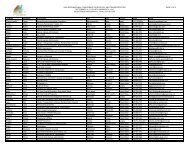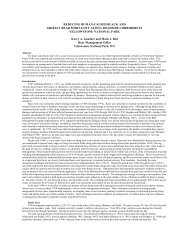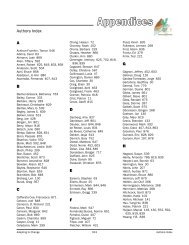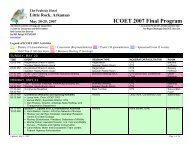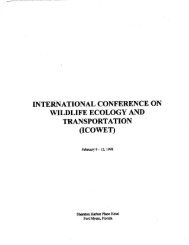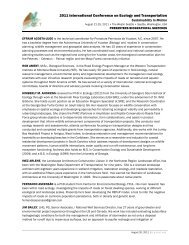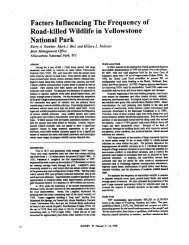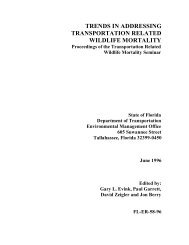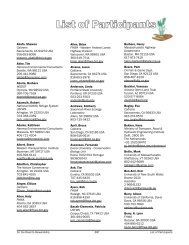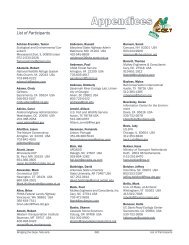COM-1, pages 179-226 - ICOET
COM-1, pages 179-226 - ICOET
COM-1, pages 179-226 - ICOET
You also want an ePaper? Increase the reach of your titles
YUMPU automatically turns print PDFs into web optimized ePapers that Google loves.
Animal Detection Systems and Data Recording EquipmentThe first system tested is a buried cable (Perimitrax®) that detects large mammals when they move across the cable(Table 1). The system is manufactured by Senstar Corporation, Carp, Ontario, Canada, and it is the exact sametechnology as originally installed along US Hwy 160 near Durango, CO, USA. The buried cable was placed in a trenchand wrapped in sand and geotextile nine inches below the surface. The system was installed in Lewistown on 11 and12 August 2009. The system generates an invisible electromagnetic field and when a large animal crosses the cable itcauses a disturbance in this electromagnetic field. The electrical conductivity, size and speed of the animal all affectthe magnitude of the disturbance. However, the threshold that needs to be met to declare an "alarm" or "detection" isadjustable and can be set depending on the size of the animal one wishes to detect. Detection messages aretransmitted to a computer in the research trailer at the test-bed where they are saved in files for later analysis.The second system tested is a microwave radio signal break-the-beam system manufactured by ICx Radar Systems(Scottsdale, Arizona (formerly Sensor Technologies and Systems, Inc.) (Table 1). The system is the third generation ofthis detection technology (RADS III). Previous generations (RADS I and RADS II) were evaluated for their reliability in anearlier project (Huijser et al. 2009b). The RADS III is the exactly the same detection technology as was installed alongHwy 3 near Fort Jones, CA, USA. The system was installed in Lewistown, MT on 16 December 2009. The center of thebeam was set at about 73.7 cm (29 inches) above the ground. However, because of rises and depressions in theterrain, the center of the beam was estimated to have varied between 71.1 and 76.2 cm (28-30 inches) above theground. Setting the center of the beam lower may have resulted in false positives as a result of the grass-herbvegetation in the enclosure.Table 1. The characteristics of the two animal detection systems.See appendix A for manufacturer contact details.Manufacturer andsystem nameMagal Senstar(Perimitrax®)STS (RADS III)SystemtypeBuriedcableBreak-thebeamSignal type Maximum range Installation dateElectromagnetic field About 0.1 mi (161 m) 11/12 Aug 2009Microwave radio (± 35.5 GHz) About 1/2 mi (804 m) 16 Dec 2009Six infrared cameras (Fuhrman Diversified, Inc.) were installed perpendicular to the detection system. These camerasand a video recording system record all animal movements within the enclosure continuously, day and night. The twosystems saved individual detection data with a date and time stamp in data logs. These data were compared to theimages from the infrared cameras, which also had a date and time stamp, allowing the researchers to investigate thereliability of the system. Orange cones marked the location of the cable (first system) and the beam (second system) onthe images.Wildlife Target Species and ModelsIn a North American setting, animal detection systems are typically designed to detect white-tailed deer (Odocoileusvirginianus) and/or mule deer (Odocoileus hemionus), pronghorn (Antilocapra americana), elk (Cervus elaphus) ormoose (Alces alces). In Montana, it is not legal to have deer, elk or moose in captivity. Therefore the researchers useddomesticated species as a model for wildlife. For this study, which took place within an enclosure, two horses, twollamas, and two sheep were used as models for these wildlife target species. Horses are similar in body shape and sizeto moose, llamas represent deer and elk, and sheep represent small deer (Tables 2 and 3). The body size and weight ofthe individual horses, llamas, and sheep used in this experiment are shown in Table 4.Reducing Wildlife-Vehicle Collisions 221 <strong>ICOET</strong> 2011 Proceedings



